 OK. One more old photo. Here is Jack painting outdoors in 1975. This was during the Art Students League days, before moving to Vermont. We used to take Frank Mason's Landscaping Painting class every June in Vermont. It always struck me that an entire group of artists would put their jobs on hold, go to Vermont, and take this month long plein air workshop. It was intense, and we worked really hard. The classes met 3 times a week: one was a sunrise class, one was a sunset class and the other one was a class where you brought in work that you did on your own for the critique. We would spend the entire month camping out, on the land where we now live, and doing landscapes. It was a lot of fun. Frank, who is now 86 years old, is still teaching this workshop every June, as well as still teaching at the Art Students League. He imparted a love of painting from life that has left an indelible mark.
OK. One more old photo. Here is Jack painting outdoors in 1975. This was during the Art Students League days, before moving to Vermont. We used to take Frank Mason's Landscaping Painting class every June in Vermont. It always struck me that an entire group of artists would put their jobs on hold, go to Vermont, and take this month long plein air workshop. It was intense, and we worked really hard. The classes met 3 times a week: one was a sunrise class, one was a sunset class and the other one was a class where you brought in work that you did on your own for the critique. We would spend the entire month camping out, on the land where we now live, and doing landscapes. It was a lot of fun. Frank, who is now 86 years old, is still teaching this workshop every June, as well as still teaching at the Art Students League. He imparted a love of painting from life that has left an indelible mark. Saturday, October 27, 2007
 OK. One more old photo. Here is Jack painting outdoors in 1975. This was during the Art Students League days, before moving to Vermont. We used to take Frank Mason's Landscaping Painting class every June in Vermont. It always struck me that an entire group of artists would put their jobs on hold, go to Vermont, and take this month long plein air workshop. It was intense, and we worked really hard. The classes met 3 times a week: one was a sunrise class, one was a sunset class and the other one was a class where you brought in work that you did on your own for the critique. We would spend the entire month camping out, on the land where we now live, and doing landscapes. It was a lot of fun. Frank, who is now 86 years old, is still teaching this workshop every June, as well as still teaching at the Art Students League. He imparted a love of painting from life that has left an indelible mark.
OK. One more old photo. Here is Jack painting outdoors in 1975. This was during the Art Students League days, before moving to Vermont. We used to take Frank Mason's Landscaping Painting class every June in Vermont. It always struck me that an entire group of artists would put their jobs on hold, go to Vermont, and take this month long plein air workshop. It was intense, and we worked really hard. The classes met 3 times a week: one was a sunrise class, one was a sunset class and the other one was a class where you brought in work that you did on your own for the critique. We would spend the entire month camping out, on the land where we now live, and doing landscapes. It was a lot of fun. Frank, who is now 86 years old, is still teaching this workshop every June, as well as still teaching at the Art Students League. He imparted a love of painting from life that has left an indelible mark.  Here is a view of the north wall in 1983. Paintings used to hang all around the room. The cabinets are now along the north wall under the window. We heated the studio, in those days, with a wood burning stove that stood in the middle with a long stove pipe, that vented to the outside, just above the window. It was pretty cold in there, and it took a while to get toasty. You can see a homemade easel and Becky is peeking out at the bottom left of the photo. This picture has good light (no flash). The light is soft and the shadows are luminous.
Here is a view of the north wall in 1983. Paintings used to hang all around the room. The cabinets are now along the north wall under the window. We heated the studio, in those days, with a wood burning stove that stood in the middle with a long stove pipe, that vented to the outside, just above the window. It was pretty cold in there, and it took a while to get toasty. You can see a homemade easel and Becky is peeking out at the bottom left of the photo. This picture has good light (no flash). The light is soft and the shadows are luminous. Here I am in 1983. The baby is my son Daniel. You can see the still life set-up and the painting. We painted a lot of hexagons for a while, and this one is on linen. Another table for still life is set up on the model stand, which is on the east side of the studio in the photo. This picture, too, was taken with a flash, so you are not getting the real light, which was very dramatic.
Here I am in 1983. The baby is my son Daniel. You can see the still life set-up and the painting. We painted a lot of hexagons for a while, and this one is on linen. Another table for still life is set up on the model stand, which is on the east side of the studio in the photo. This picture, too, was taken with a flash, so you are not getting the real light, which was very dramatic. Here is a picture of Jack in the studio in 1981. He is sitting on the model stand against the south wall. Note that this is pre-water heater and pre great shelf. We used to have paintings hanging all around the room and stacked along the floor. You can see the door to the outside, which is on the east side of the studio.
Here is a picture of Jack in the studio in 1981. He is sitting on the model stand against the south wall. Note that this is pre-water heater and pre great shelf. We used to have paintings hanging all around the room and stacked along the floor. You can see the door to the outside, which is on the east side of the studio. Well, here I am in 1981. The baby in the backpack is my daughter Elisabeth. As you can see, some things never change.....I still paint and hold babies at the same time (see the first photo at the beginning of my blog). My old easel is holding a still life that I did that year of nasturtiums. Behind me is the south wall of the studio with the door that leads into the house. The studio was a cream color then, and we didn't envision having to have so many shelves and storage racks. You can see another one of my casts on the wall. The camera had an automatic flash, so you are not getting the real "studio light".
Well, here I am in 1981. The baby in the backpack is my daughter Elisabeth. As you can see, some things never change.....I still paint and hold babies at the same time (see the first photo at the beginning of my blog). My old easel is holding a still life that I did that year of nasturtiums. Behind me is the south wall of the studio with the door that leads into the house. The studio was a cream color then, and we didn't envision having to have so many shelves and storage racks. You can see another one of my casts on the wall. The camera had an automatic flash, so you are not getting the real "studio light".Studio Photo Explanations
My easel (present this year) stands on the west side of the room. You can see my still life table with its faux marble top and painting storage racks below. Jack built this, too. I set up still life here, as well as on the dresser to the right of this. So, my light usually come from the above right, unless I get to set up on the other side of the room. Jack also built the painting storage racks to the left of the still life table. Storage is a problem if you are a prolific painter.
On the east side of the room is Jack's easel with a landscape that he is working up from one of his plein air studies. The study is on my old easel which is to the right of this. You can see our skeleton, some pigments, a model stand which is covered with boxes of mat board at the moment, and another storage thing with props in front of a door to the outside.
On the south side, there is a shelf that runs across the room with more stored paintings, and yes, you guessed it....Jack built this, too. You can also see our water heater, the huge frame that was on one of Jack's large paintings that hung in the store, some mahl sticks and a dart board (go figure). The quote that runs along the bottom of the shelf is by J. M. Whistler and reads:
As music is the poetry of sound, so is painting the poetry of sight.
Since I consider myself a poetic realist, this quote says it all. I love quotes and have them around the studio for inspiration and help.
So, that's my studio...somewhat messy, somewhat disorganized, somewhat corny, but with dramatic light that lends mystery and importance to somewhat ordinary objects.
Tuesday, October 23, 2007
Saturday, September 15, 2007
Another floral
 The flowers are at the end of the season. Autumn is just about here, so this is one of the last offerings from the tired garden. This is another start. I have a light colored backdrop behind the set up to compliment the colors. I like to alternate my backgrounds. It keeps me from falling into a "formula". Actively solving a visual problem takes effort. My studio is crammed with props, panels, canvases, paints and supplies, as you can see.
The flowers are at the end of the season. Autumn is just about here, so this is one of the last offerings from the tired garden. This is another start. I have a light colored backdrop behind the set up to compliment the colors. I like to alternate my backgrounds. It keeps me from falling into a "formula". Actively solving a visual problem takes effort. My studio is crammed with props, panels, canvases, paints and supplies, as you can see.Palette
Head Study
.jpg) This is another 1 hour (mayble 1 1/2) alla prima head study. It is an oil on panel. Finding the correct pitch and value relationship was imperative. I painted this one as a demo at 100 Main Street Fine Art (www.visionsofvermont.org) where I am currently showing.
This is another 1 hour (mayble 1 1/2) alla prima head study. It is an oil on panel. Finding the correct pitch and value relationship was imperative. I painted this one as a demo at 100 Main Street Fine Art (www.visionsofvermont.org) where I am currently showing. More demos

 Here I am painting another demo for a plein air landscape class that I taught in CT for Sylvan Gallery (http://www.sylvangallery.com/). Outdoor painting takes a great deal of preparation. I mix a value scale of landscape colors so that I can paint very fast. You can only paint for 2 (maybe 3) hours before the light is so completely different, which of course, changes the whole painting. Most of my paintings are small oil sketches. Painting and explaining why I am using certain colors and principles are very helpful to new artists. It is invaluable to a student to see how an artist works and solves a visual problem. I ask questions so that the students can see what I am trying to solve, so my demos are interactive. Being able to answer the questions is a form of mental painting, and mental painting comes before the physical. It gives you a direction, and by actively being engaged in problem solving, keeps the painting moving forward. The workshop format is intensive. It is for learning how to start and use artistic principles rather than trying to complete a salable painting. All of my classes are process oriented, not project oriented. The student, then, returns home armed with information that they can incorporate into their own work at their own pace.
Here I am painting another demo for a plein air landscape class that I taught in CT for Sylvan Gallery (http://www.sylvangallery.com/). Outdoor painting takes a great deal of preparation. I mix a value scale of landscape colors so that I can paint very fast. You can only paint for 2 (maybe 3) hours before the light is so completely different, which of course, changes the whole painting. Most of my paintings are small oil sketches. Painting and explaining why I am using certain colors and principles are very helpful to new artists. It is invaluable to a student to see how an artist works and solves a visual problem. I ask questions so that the students can see what I am trying to solve, so my demos are interactive. Being able to answer the questions is a form of mental painting, and mental painting comes before the physical. It gives you a direction, and by actively being engaged in problem solving, keeps the painting moving forward. The workshop format is intensive. It is for learning how to start and use artistic principles rather than trying to complete a salable painting. All of my classes are process oriented, not project oriented. The student, then, returns home armed with information that they can incorporate into their own work at their own pace.Demos
 So, what have I been up to this summer?....lots of demos & lots of teaching. This was a 1 1/2 hour Alla Prima portrait demo that I did at the Southern Vermont Art Center in July. I am teaching a Portrait Painting Clinic there September 21-22 (www.svac.org) and another at the Lyme Art Association October 6-7 (www.lymeartassociation.org). Executing a quick study involves setting down the right "pitch" and manipulating the value scale decisively to create a relative light effect. Here, my brighted note was in the model's hair.
So, what have I been up to this summer?....lots of demos & lots of teaching. This was a 1 1/2 hour Alla Prima portrait demo that I did at the Southern Vermont Art Center in July. I am teaching a Portrait Painting Clinic there September 21-22 (www.svac.org) and another at the Lyme Art Association October 6-7 (www.lymeartassociation.org). Executing a quick study involves setting down the right "pitch" and manipulating the value scale decisively to create a relative light effect. Here, my brighted note was in the model's hair.Thursday, August 02, 2007
Easels
 This is a plein air painting, or field study. That means that it is done outdoors, directly from nature. Jack will usually make a larger painting, in the studio, from his studies. Good draftsmanship is important, and learning to "draw with the brush" takes skill. To steady his hand, Jack always uses a mahl stick.
This is a plein air painting, or field study. That means that it is done outdoors, directly from nature. Jack will usually make a larger painting, in the studio, from his studies. Good draftsmanship is important, and learning to "draw with the brush" takes skill. To steady his hand, Jack always uses a mahl stick.Easels
 Painting is a solitary activity. The artist is working out his composition, and is actively engaged in visual problem solving. It takes a great deal of thought to paint a good picture. The artist must find equipment that suits his/her needs and temperament. This is my husband Jack. He uses a portable steel easel which fits nicely on his motorcycle. The palette box breaks down into 2 sections, so that it is compact as well. A juice can serves as a brush holder and hangs off the box for easy access. To paint well, your equipment must serve, not hinder, your creativity.
Painting is a solitary activity. The artist is working out his composition, and is actively engaged in visual problem solving. It takes a great deal of thought to paint a good picture. The artist must find equipment that suits his/her needs and temperament. This is my husband Jack. He uses a portable steel easel which fits nicely on his motorcycle. The palette box breaks down into 2 sections, so that it is compact as well. A juice can serves as a brush holder and hangs off the box for easy access. To paint well, your equipment must serve, not hinder, your creativity.Thursday, June 21, 2007
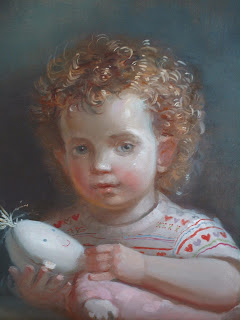.jpg) This is Violet Pepper my granddaughter. I did this painting when she was 17 months old. When you paint little children....you need a team to entertain, distract and comfort them, so that they will keep looking in the right direction. Both parents took turns having her sit on their laps, reading her stories and singing her songs. Painting fast definitely helps!
This is Violet Pepper my granddaughter. I did this painting when she was 17 months old. When you paint little children....you need a team to entertain, distract and comfort them, so that they will keep looking in the right direction. Both parents took turns having her sit on their laps, reading her stories and singing her songs. Painting fast definitely helps!More Children
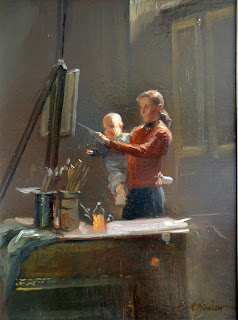 Every artist wants to do something really good...some big "important" piece...something to wow the crowds. But, in truth, some of our best paintings are the ones closest to our hearts. They may be small, but they will always make us smile. The struggle to paint a self-portrait while holding a baby is actually quite a challenge, but to actually do it....now, that is an accomplishment! This little painting will always rank among my all-time favorites. The baby is my youngest daughter, Annie.
Every artist wants to do something really good...some big "important" piece...something to wow the crowds. But, in truth, some of our best paintings are the ones closest to our hearts. They may be small, but they will always make us smile. The struggle to paint a self-portrait while holding a baby is actually quite a challenge, but to actually do it....now, that is an accomplishment! This little painting will always rank among my all-time favorites. The baby is my youngest daughter, Annie. Wednesday, June 20, 2007
Children
.jpg) Here is another interior of Becky and Lizzie in the studio. Studio props, casts and supplies are all around. The cast behind Becky's head is Nike tying her Sandal, and since Rebekah is tying her Nike, the title of the painting is Nikes. The studio walls are now much darker, and the girls are much bigger!
Here is another interior of Becky and Lizzie in the studio. Studio props, casts and supplies are all around. The cast behind Becky's head is Nike tying her Sandal, and since Rebekah is tying her Nike, the title of the painting is Nikes. The studio walls are now much darker, and the girls are much bigger!Tuesday, June 19, 2007
More Watercolors
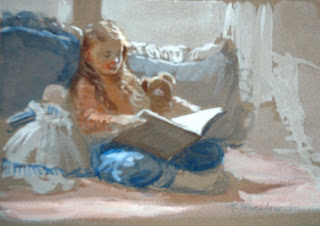.jpg) I use watercolor for all subjects, too. This is a little interior that I did of Priscilla when she was little. Watercolors are easy to set up, as well as clean up, and I usually use them when I cannot use my oils. Hmmm, it is beginning to look like I only painted one of my children. Trust me. They've all posed.
I use watercolor for all subjects, too. This is a little interior that I did of Priscilla when she was little. Watercolors are easy to set up, as well as clean up, and I usually use them when I cannot use my oils. Hmmm, it is beginning to look like I only painted one of my children. Trust me. They've all posed.More Watercolors
.jpg) Watercolors are really handy in the winter. I keep a little set in the car, so if I see something that inspires me, I can pull over and paint looking out the window, in the comfort and warmth of the car. Doing oils outdoors in the winter is really really cold, and the paint gets extremely difficult to move around. This little one was done from the car.
Watercolors are really handy in the winter. I keep a little set in the car, so if I see something that inspires me, I can pull over and paint looking out the window, in the comfort and warmth of the car. Doing oils outdoors in the winter is really really cold, and the paint gets extremely difficult to move around. This little one was done from the car.Monday, June 18, 2007
Helpful Hints
Helpful hints? You bet! When I teach, I try to get students to simplify what they are looking at into masses, or shapes of values. The easiest way to do this is to squint. Squinting is great, and it is the cheapest aid to learning to mass. Next to squinting, though, a reducing glass is wonderful! Thanks to another nice picture from Jim Comly (taken May 27, 2007 at the Southern Vermont Art Center demo), you can see that a reducing glass....well....reduces. It is just the opposite of a magnifying glass. By making things smaller, you do not see too many details, and seeing too many details, before seeing the general masses and underlying structure, is what holds beginners back. So, a reducing glass helps to simplify...very important! In addition to this, I use a reducing glass to view my painting, if I can't actually step back from my work. It gives the illusion of standing really far away.
Watercolors
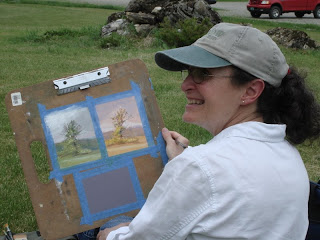 In case you were wondering about my watercolors....they are very small. The ones that I just showed from Monhegan are about the same size as the ones taped to the clipboard in this photo. This is a picture (courtesy of Jim Comly), of a demo (well, 2) that I did recently for the Southern Vermont Art Center (http://www.svac.org/), in Manchester, VT, where I am teaching a class called, Walk & Watercolor in July. Different colored paper will give me a different effect, and it is fun to experiment.
In case you were wondering about my watercolors....they are very small. The ones that I just showed from Monhegan are about the same size as the ones taped to the clipboard in this photo. This is a picture (courtesy of Jim Comly), of a demo (well, 2) that I did recently for the Southern Vermont Art Center (http://www.svac.org/), in Manchester, VT, where I am teaching a class called, Walk & Watercolor in July. Different colored paper will give me a different effect, and it is fun to experiment.A Look Back ~ Monhegan Revisited
.jpg) Before my recent painting trip to Monhegan (June 4-10, 2007), I painted there 16 years ago. At that time, I was there with Jack (my husband & fellow artist) and our 5 children. After a few days of lugging my French easel around and doing oils, I turned to my other medium...watercolors. They are much lighter, so hence, much easier to transport. In addition, they dry quickly, and they are easier to store, with little or no damage. This is a quick little study of my daughter, Priscilla, sitting on the rocks by the harbor in morning light. It is 16 years old! It is funny to see how little Monhegan has changed. Priscilla, on the other hand, now has children of her own. Time flies!
Before my recent painting trip to Monhegan (June 4-10, 2007), I painted there 16 years ago. At that time, I was there with Jack (my husband & fellow artist) and our 5 children. After a few days of lugging my French easel around and doing oils, I turned to my other medium...watercolors. They are much lighter, so hence, much easier to transport. In addition, they dry quickly, and they are easier to store, with little or no damage. This is a quick little study of my daughter, Priscilla, sitting on the rocks by the harbor in morning light. It is 16 years old! It is funny to see how little Monhegan has changed. Priscilla, on the other hand, now has children of her own. Time flies!Sunday, June 17, 2007
Still life - Peonies
.jpg) I've added more foliage and more lilies on the right. My daughter, her husband and my wonderful grandchildren showed up for Father's Day dinner, so this is as far as I can go today. I am off to a good start, and I will try to keep the painting fresh and moving towards a unified light effect. By tomorrow, the flowers in the set-up will be very different. Some will be full blown, and some will probably be a pile of petals on the table. I will need to replace the flower in the set-up that I had originally placed on the table, as it has now collasped. In case you were wondering, I am doing this painting on a panel.
I've added more foliage and more lilies on the right. My daughter, her husband and my wonderful grandchildren showed up for Father's Day dinner, so this is as far as I can go today. I am off to a good start, and I will try to keep the painting fresh and moving towards a unified light effect. By tomorrow, the flowers in the set-up will be very different. Some will be full blown, and some will probably be a pile of petals on the table. I will need to replace the flower in the set-up that I had originally placed on the table, as it has now collasped. In case you were wondering, I am doing this painting on a panel.Painting a still life
 I worked on the pink peonies first. Trying to hold onto the illusion of space, by keeping that foremost peony projecting out towards me, was my goal. Then, I began adding the Lemon Liles. Although, they are bright yellow, the main peony still hangs out in front. This will remain the battle in this painting. I step back often. Viewing my work from a distance is very important. If it doesn't "read" from across the room, something is wrong.
I worked on the pink peonies first. Trying to hold onto the illusion of space, by keeping that foremost peony projecting out towards me, was my goal. Then, I began adding the Lemon Liles. Although, they are bright yellow, the main peony still hangs out in front. This will remain the battle in this painting. I step back often. Viewing my work from a distance is very important. If it doesn't "read" from across the room, something is wrong.Painting a still life
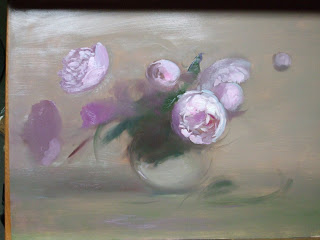 As anyone who paints from life knows, if you paint real flowers....they move towards the light, continue to open, or just droop after a while. So, you need to paint the most important flowers quickly....before they change. After establishing my background and pitching the tones to get the relative effect, I begin to mass my lights and darks. I use large brushes and try to simplify my design into basic shapes and patterns, looking for connections and rhythms.
As anyone who paints from life knows, if you paint real flowers....they move towards the light, continue to open, or just droop after a while. So, you need to paint the most important flowers quickly....before they change. After establishing my background and pitching the tones to get the relative effect, I begin to mass my lights and darks. I use large brushes and try to simplify my design into basic shapes and patterns, looking for connections and rhythms.Starting a still life
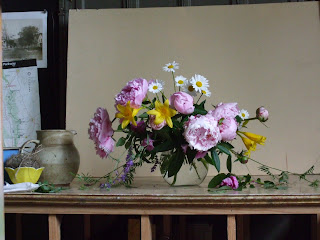 The peonies in my garden are at their height, and if I didn't paint them today, I would miss my opportunity for this year. I usually like them when they are in a tight ball, but with the heat and humidity, they were opening very fast. So, I cut a bunch of flowers and set up this still life in my studio. The light comes from a north facing window that starts about 8' off the ground. I put a board behind the set up to give myself a light background. I always stand when I paint, so this is about eye level.
The peonies in my garden are at their height, and if I didn't paint them today, I would miss my opportunity for this year. I usually like them when they are in a tight ball, but with the heat and humidity, they were opening very fast. So, I cut a bunch of flowers and set up this still life in my studio. The light comes from a north facing window that starts about 8' off the ground. I put a board behind the set up to give myself a light background. I always stand when I paint, so this is about eye level.Saturday, June 16, 2007
Still More from Monhegan
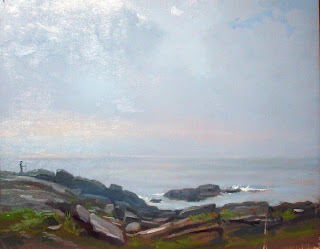.jpg) Here is one from Lobster Cove. The little figure on the left is Ann painting on the rocks. The surf, as you can see, was pretty flat, but the sky and the sparkles on the waves were exciting. This painting, too, was scraped up a bit. Transporting wet paintings is always a project. I guess I should have used a faster drying medium, because all of my paintings remained wet, which is why I had problems getting them home safefly. I will try to touch up the scrapes that you can see on the right. All of my paintings from this trip were done on panels.
Here is one from Lobster Cove. The little figure on the left is Ann painting on the rocks. The surf, as you can see, was pretty flat, but the sky and the sparkles on the waves were exciting. This painting, too, was scraped up a bit. Transporting wet paintings is always a project. I guess I should have used a faster drying medium, because all of my paintings remained wet, which is why I had problems getting them home safefly. I will try to touch up the scrapes that you can see on the right. All of my paintings from this trip were done on panels.More Paintings from Monhegan
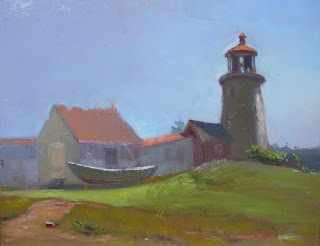.jpg) OK. So, here is another midday painting. It is up by the lighthouse. Lizzie and Ann were painting along the path in "town", and I decided to look around. I kept looking further and further down the path, and nothing really called to me. Then, I took a skinny trail, which wound up going all the way around the marsh, and somehow, I ended up at the lighthouse. So, I painted...I did enough hiking. From my perch on the hill, I could see the path where my buddies were painting, but a building blocked my actually seeing them. I kept checking to see if they were heading back to the Trailing Yew, but EVERYONE walking seemed to have backpacks, easels and wide brimmed sunhats. I painted until the light was way too different, then, I headed down. Lizzie & Ann were just cleaning up, and we all headed back to get ready for the next painting. This one got pretty messy, but I'll try to fix that roofline soon.
OK. So, here is another midday painting. It is up by the lighthouse. Lizzie and Ann were painting along the path in "town", and I decided to look around. I kept looking further and further down the path, and nothing really called to me. Then, I took a skinny trail, which wound up going all the way around the marsh, and somehow, I ended up at the lighthouse. So, I painted...I did enough hiking. From my perch on the hill, I could see the path where my buddies were painting, but a building blocked my actually seeing them. I kept checking to see if they were heading back to the Trailing Yew, but EVERYONE walking seemed to have backpacks, easels and wide brimmed sunhats. I painted until the light was way too different, then, I headed down. Lizzie & Ann were just cleaning up, and we all headed back to get ready for the next painting. This one got pretty messy, but I'll try to fix that roofline soon.More Paintings of Monhegan
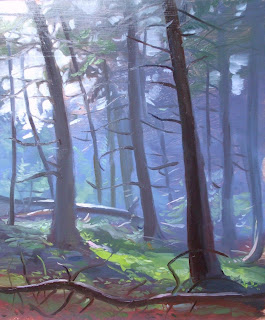.jpg) Painting midday is often a drag because the light comes down harsh and the shadows hide as though they are trying to stay out of the sun. Artists prefer to paint early or late in the day, when the shadows are long and inviting. Midday is also usually hot too, and you will wind up with a massive sunburn, which at my age, doesn't help with the wrinkles. So, since we were here to paint, we all decided to paint midday anyhow and an interior in the forest was perfect...it was cool and the light filtering down was magical. To my surprise, the bugs weren't biting, yet.
Painting midday is often a drag because the light comes down harsh and the shadows hide as though they are trying to stay out of the sun. Artists prefer to paint early or late in the day, when the shadows are long and inviting. Midday is also usually hot too, and you will wind up with a massive sunburn, which at my age, doesn't help with the wrinkles. So, since we were here to paint, we all decided to paint midday anyhow and an interior in the forest was perfect...it was cool and the light filtering down was magical. To my surprise, the bugs weren't biting, yet.More Paintings from Monhegan
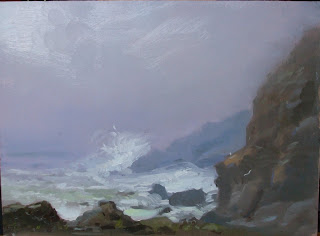.jpg) This is the first painting I did on Monhegan. We hiked out to White Head, and huge waves were crashing against the rocks. The fog and mists made it a spectacular site, and Ann, Lizzie and I were really stoked! We were really wishing for a repeat for the rest of the week, but the fogs cleared and the seas flatten :( I am glad that we decided to paint here first! It was really special.
This is the first painting I did on Monhegan. We hiked out to White Head, and huge waves were crashing against the rocks. The fog and mists made it a spectacular site, and Ann, Lizzie and I were really stoked! We were really wishing for a repeat for the rest of the week, but the fogs cleared and the seas flatten :( I am glad that we decided to paint here first! It was really special.Painting Trip ~ Monhegan
.jpg) Here is the painting I was working on. It is at Fish Beach, and Lizzie is doing a painting looking towards the harbor. As I was working on this, a fisherman kept taking away the various boats..so I had to paint extra fast! All of my paintings were wet when we left the island, and the container I had to cradle them, was flipped over and turned on its side, so most of my paintings were smeared and scratched. You can see this on the top of the buildings. I will try to restore them when I have time.
Here is the painting I was working on. It is at Fish Beach, and Lizzie is doing a painting looking towards the harbor. As I was working on this, a fisherman kept taking away the various boats..so I had to paint extra fast! All of my paintings were wet when we left the island, and the container I had to cradle them, was flipped over and turned on its side, so most of my paintings were smeared and scratched. You can see this on the top of the buildings. I will try to restore them when I have time.Painting Trip ~ Monhegan
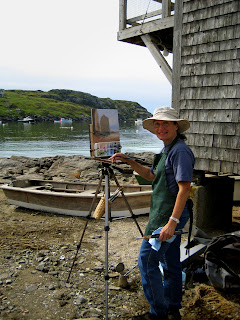 I recently took a painting trip to Monhegan in Maine. It is a little island about 12 miles out to sea from Port Clyde. Monhegan has been attracking artists since the early 1900s, and the lure is still strong today. High cliffs with pounding surf form the east side of the island, while cute fish shanties, quaint houses and a snug harbor line the west side. An enchanted forest lies in between, and hiking trails run east and west, as well as around the island. Artists abound, and it is fun to meet new friends. No cars are allowed on the island. I went with 2 painting buddies, Ann and Lizzie, who also studied at the Art Students League with Frank Mason. We hiked and painted like maniacs from Tuesday to Saturday, and I managed to do 13 oils, 2 watercolors and a couple of drawings in those 5 days. Like I first said...I paint a lot... This was the last oil I did on Saturday. Lizzie has a really good blog (actually 2), and you can see the paintings she did on her blog: www.etorak.blogspot.com. This painting has a little figure in it. The figure is Lizzie painting and looking out towards the harbor with a guy rowing (you can see it on her site).
I recently took a painting trip to Monhegan in Maine. It is a little island about 12 miles out to sea from Port Clyde. Monhegan has been attracking artists since the early 1900s, and the lure is still strong today. High cliffs with pounding surf form the east side of the island, while cute fish shanties, quaint houses and a snug harbor line the west side. An enchanted forest lies in between, and hiking trails run east and west, as well as around the island. Artists abound, and it is fun to meet new friends. No cars are allowed on the island. I went with 2 painting buddies, Ann and Lizzie, who also studied at the Art Students League with Frank Mason. We hiked and painted like maniacs from Tuesday to Saturday, and I managed to do 13 oils, 2 watercolors and a couple of drawings in those 5 days. Like I first said...I paint a lot... This was the last oil I did on Saturday. Lizzie has a really good blog (actually 2), and you can see the paintings she did on her blog: www.etorak.blogspot.com. This painting has a little figure in it. The figure is Lizzie painting and looking out towards the harbor with a guy rowing (you can see it on her site).Thursday, June 14, 2007
Website
Teaching

Wednesday, June 13, 2007

Priscilla is posing by a north facing window in the storefront that I rented and used as my Studio/ Gallery. People could come in and watch as I painted. I always had several set-ups (mostly still life) at different stations throughout the storefront. More details and specific colors and features were added as the painting developed. The finished painting, Stylin' , sold at Sylvan Gallery, where I am also represented.
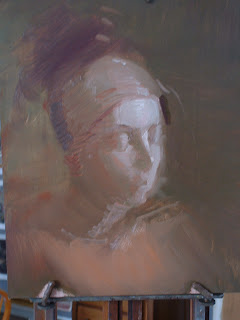.jpg)
I always paint directly from life, and I always paint from the general shapes, or masses, to the specific details. This is how I was trained, so that I am drawing and painting at the same time. It forces me to draw with the brush, which in turn, keeps the painting fresh and exciting, and it gives me ultimate freedom. This is the "start" of the portrait. I used large brushes and broad, general shapes to indicate form and light.
No Excuses
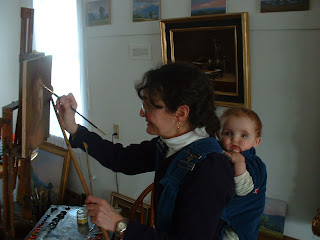








.jpg)
.jpg)
.jpg)

.jpg)


